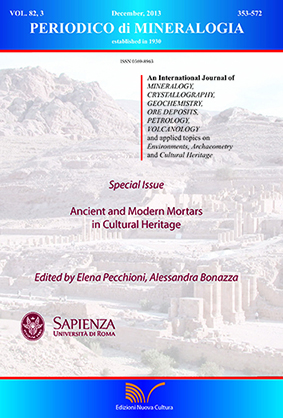Investigation about ancient mortars and plasters in the Mondovì cathedral (Cuneo, Italy)
DOI:
https://doi.org/10.2451/2013PM0025Keywords:
Mortar, Plaster, EDS Maps, Cultural Heritage, Mondovì CathedralAbstract
St. Donato Cathedral of Mondovi (Cuneo Province, North-West Italy) is the last project of the famous architect Francesco Gallo (1672-1750). The construction started in 1744, but it has been consecrated only in 1763. The building is an impressive brick-made church with a main nave and two lateral aisles, which remarkable length is 56 meters and it is 24 meters wide. Its style is mainly baroque with some neoclassical additions. After the edification, the decoration of the interior walls was very simple; probably it was a white finish of smooth plaster consisting of lime and magnesian lime mortar. There are some evidences of a basic decoration: a uniform bluish or grayish tinge. Around 1850 a plan for a new decorative apparatus was made and some of the most important painters of that period were committed to paint sacred subjects on the vault and apse, and to provide the decorations of the walls. In early 2012 started some important restoration works in the Cathedral. One of the main purpose of the Restoration Team is to get scientific and historical information about the work of ancient painters and decorators. The scientific investigation on mortar layers was conducted on various samples, several of them were resin included polished sections, using Optical Microscopy (OM) and Scanning Electron Microscopy (SEM) supported by Energy Dispersive Microprobe spectroscopy (EDS). The analyses carried out on the samples clearly showed the historical stratifications of different layers. The first stratification is made of mortars and plasters dating around the middle of 18th century, and shows different compositions and very neat layers. While the last stratification is a more recent mortar plaster, which is coarse-grained, used as a background for the new decorations done in the middle of 19th century.


